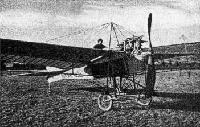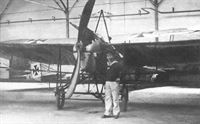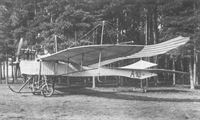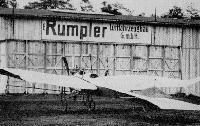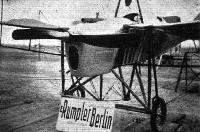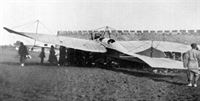
Описание
Страна: Германия
Год: 1911
В.Кондратьев Самолеты первой мировой войны
Двухместный расчалочный моноплан цельнодеревянной конструкции с дополнительным внешним лонжероном под крылом и полотняной обшивкой. Управление по крену гошированием, а по вертикали - отклонением задней кромки стабилизатора. Оригинальный самолет, напоминающий птицу (нем. "Taube" - "голубь") спроектирован в 1910 году австрийским инженером Иго Этрихом. Эта машина стала популярной еще в предвоенные годы, поскольку имела хорошие летные данные и простое управление. Кроме того, она стала и одним из первых боевых самолетов: применялась итальянцами в качестве разведчика и бомбардировщика в войне с Турцией в 1910 г. Самолет выпускался как по лицензии, так и без нее на многих германских и австрийских фирмах, где в конструкцию вносились собственные доработки и изменения, в том числе Румплер, Хальберштадт, Фоккер, Альбатрос, Гота, DFW и Джаннин. В германской военной авиации самолет имел индекс А-1.
Машины разных производителей имели серьезные геометрические и конструктивные различия.
"Таубе" компании "Гота" по конструкции был наиболее близок к оригиналу. Он представлял собой деревянный расчалочный моноплан с фюзеляжем ферменного типа. Самолет не имел ни элеронов, ни рулей высоты: крыло гошировалось, а по вертикали он управлялся отклонением задней кромки стабилизатора. На серийных машинах устанавливался двигатель Мерседес или Аргус.
Аппараты фирмы Хальберштадт имели фюзеляж типа полумонокок и "классическую" схему управления с рулями и элеронами, а самолеты фирм DFW и Джаннин строились с цельнометаллическим силовым набором из стальных труб (так называемые "Штальтаубе").
Компания "Румплер" выпускала несколько вариантов "Таубе", в том числе и на поплавковом шасси. Эти самолеты отличались двигателями, конструкцией шасси, поверхностями управления - первые варианты не имели элеронов и рулей на хвостовом оперении.
За годы серийного выпуска из заводских цехов вышло свыше 500 аэропланов, большинство из которых на счету фирмы Румплер.
В августе 1914 года все самолеты, принадлежавшие частным владельцам на территории Германии, были реквизированы и приписаны к военно-воздушным силам. При этом "Таубе" присвоили индекс А-1. (В немецкой военной классификации буквой "А" обозначали невооруженные монопланы).
В первые месяцы войны "Таубе" наиболее часто применялись для разведки как на западном, так и на восточном фронте. Самолеты этого типа сыграли важную роль в битве на Марне и в отражении русского наступления на Восточную Пруссию. 30 августа 1914 г лейтенант фон Хингессен сбросил с Румплер "Таубе" 3 ручные гранаты и листовки на Париж, совершив тем самым первую в истории воздушную бомбардировку города.
К началу 1915 года аппараты Этриха постепенно уступают место более современным разведчикам бипланной схемы. В учебных частях "Таубе" эксплуатировались еще более двух лет.
ДВИГАТЕЛЬ
"Австро-Даймлер", 120 л.с. (на машинах австрийской постройки) или "Мерседес", 100 л.с. или "Аргус" той же мощности. В отдельных случаях применялись и другие типы рядных моторов водяного охлаждения.
ВООРУЖЕНИЕ
Не предусмотрено.
ЛЕТНО-ТЕХНИЧЕСКИЕ ХАРАКТЕРИСТИКИ
"Гота-Таубе" "Румплер-Таубе"
Размах, м 14,5 13,6
Длина, м 10,0 8,6
Площадь крыла, кв.м 33,4 28,9
Сухой вес, кг 690 600
Взлетный вес, кг 1026 980
Скорость максимальная, км/ч 96 105
Время набора высоты, м/мин 800/12 ?
Потолок, м 3000 ?
Продолжительность полета, ч 4 ?
Описание:
- В.Кондратьев Самолеты первой мировой войны
- J.Herris Rumpler Aircraft of WWI (A Centennial Perspective on Great War Airplanes 11)
- M.Dusing German Aviation Industry in WWI. Volume 2 (A Centennial Perspective on Great War Airplanes 85)
- Jane's All The World Aircraft 1913
- R.Mikesh, A.Shorzoe Japanese Aircraft, 1910-1941 (Putnam)
- Журнал Flight
Фотографии
-
J.Herris - Rumpler Aircraft of WWI /Centennial Perspective/ (11)
Early Rumpler Taube displaying the characteristic Taube wing and tail planform.
-
M.Dusing - German Aviation Industry in WWI. Volume 1 /Centennial Perspective/ (84)
Etrich-Rumpler-Taube with Argus engine (1910).
-
P.Jarrett - Pioneer Aircraft: Early Aviation Before 1914 /Putnam/
A classic German design of 1912 was the Rumpler Taube monoplane, so named because of the dove-like planform of its wings, which had generous external bracing.
-
J.Herris - Rumpler Aircraft of WWI /Centennial Perspective/ (11)
The Navy used land-based Rumpler Taube in addition to Rumpler Taube floatplanes. Rumpler Taube given Naval serials include S8, S9, S20, S21, S22, S42 (formerly A.131/13), and S43 (formerly A.133/13), the last two transferred from the Army.
-
K.Delve - World War One in the Air /Crowood/
Postcard of a flyer in front of an early Rumpler Taube. Various companies produced Taube designs, a number of which saw operational service, but it is the Rumpler version that is best remembered.
-
M.Dusing - German & Austro-Hungarian Aero Engines of WWI. Vol.2 /Centennial Perspective/ (65)
Rumpler-Etrich-Taube with Daimler engine before departure to Munich. [1911]
-
M.Dusing - German & Austro-Hungarian Aero Engines of WWI. Vol.1 /Centennial Perspective/ (64)
Argus 100hp in Rumpler. [1912]
-
M.Dusing - German & Austro-Hungarian Aero Engines of WWI. Vol.2 /Centennial Perspective/ (65)
Mercedes 70 hp 4-cylinder aeroengine E4F (Model 1911), Hirth won the Kathreiner Prize on his Taube equipped with this E4F engine. [1912]
-
M.Dusing - German Aviation Industry in WWI. Volume 1 /Centennial Perspective/ (84)
From April 1, 1914, Alfred Friedrich was chief pilot at Rumpler-Flugzeugwerke in Berlin-Johannisthal. In June, he caused a sensation with his flights Berlin-Sofia, where he wanted to demonstrate German flying equipment, and Sofia-Bucharest, which was the first overflight of the Balkan Mountains with a passenger. Also noteworthy was his Berlin-Paris-London-Berlin round trip on September 6, 1913, in an Etrich-Rumpler-Taube. The photo shows Etrich as Friedrichs observer on his flight from Paris to London (the aircraft shown are not identical).
-
M.Dusing - German Aviation Industry in WWI. Volume 1 /Centennial Perspective/ (84)
From April 1, 1914, Alfred Friedrich was chief pilot at Rumpler-Flugzeugwerke in Berlin-Johannisthal. In June, he caused a sensation with his flights Berlin-Sofia, where he wanted to demonstrate German flying equipment, and Sofia-Bucharest, which was the first overflight of the Balkan Mountains with a passenger. Also noteworthy was his Berlin-Paris-London-Berlin round trip on September 6, 1913, in an Etrich-Rumpler-Taube.
-
J.Herris - Rumpler Aircraft of WWI /Centennial Perspective/ (11)
Rumpler Taube A.10/12 was an early, pre-war aircraft with a four-cylinder Argus engine. The observer was seated in front for best visibility, and the aft-seated pilot had wing cut-outs for enhanced downward field of view.
-
K.Delve - World War One in the Air /Crowood/
Early Rumpler Taube.
-
O.Thetford, P.Gray - German Aircraft of the First World War /Putnam/
Rumpler Eindecker
-
Журнал - Flight за 1914 г.
A Rumpler Taube with a 100 h.p. inverted Mercedes engine.
Rumpler Monoplane with cowling for Mercedes E4uF with hanging cylinders. [1913] -
J.Herris - Development of German Warplanes in WWI /Centennial Perspective/ (1)
The Rumpler Taube shown here was the only aircraft available to the German garrison in China. After the aircraft was damaged beyond repair in a bad landing, the pilot, Lt. Plushow, had a remarkable adventure returning to Germany.
The inherently stable Tauben were too stable for air combat and their high drag limited performance. The position of the wing also limited the observer's field of view. Tauben soon disappeared from the front, replaced by higher-performance biplanes. (Aeronaut) -
Форум - Breguet's Aircraft Challenge /WWW/
Gunther Pluschow flew that Etrich Rumpler Taube around Tsingtao China.
-
J.Herris - Rumpler Aircraft of WWI /Centennial Perspective/ (11)
Early Rumpler Taube displaying the characteristic Taube wing and tail planform.
A series of German aeroplanes at Johannisthal from photographs kindly sent to us by the Hon. Lady Shelley. - Rumpler-Taube in flight. -
J.Herris - Development of German Warplanes in WWI /Centennial Perspective/ (1)
Early flight was hazardous at best, and stability was a prized attribute of primitive airplanes. The Taube (dove) wing planform offered great natural stability and many German designers used it for that reason. A small number of Tauben equipped German units at the beginning of the war, but the Taube was soon replaced by biplanes of greater performance. Despite its inherent stability, this one ended up on its nose while landing on a rough field, a common problem.
Taube on its nose shows its unusual wing planform. Taube designs were inherently stable and were used for that reason despite their high drag, low performance, and limited maneuverability. The wing planform was the opposite of the tapered wings with narrower chord at the tips. Due to their high drag that limited performance, the Taube designs were replaced by more conventional biplanes with better performance as soon as possible after the war started. -
M.Dusing - German Aviation Industry in WWI. Volume 1 /Centennial Perspective/ (84)
First Navy aircraft: Taube on floats. The Fritzsche monoplane took off from Sonderburg, on the island of Alsen, with First Lieutenant Low as pilot and Captain Lieutenant Busch as guest on its overseas flight to Kiel on June 18, 1911.
[Otto Fritzsche, Oberleutnant z. See, Kiel
Tandem monoplane 1908. Unable to fly. (In 1911 Rumpler rebuilt the plane to a Taube which became E1 in het German Navy).] -
Jane's All The World Aircraft 1913 /Jane's/
Rumpler. Hydro-aeroplane.
-
M.Dusing - German Aviation Industry in WWI. Volume 2 /Centennial Perspective/ (85)
Rumpler Wasser-Eindecker 3F (1913)
-
Форум - Breguet's Aircraft Challenge /WWW/
Rumpler experimental pusher floatplane Taube (Germany, 1913) Rumpler built in 1912-1913 a small number of Taube floatplanes, two with a single float and the others with two floats. This machine seems to have been built in late 1913. It was a pusher, powered by a 100 hp Daimler, and had two floats and a four-blade propeller. The photo was taken at the Johannisthal works.
-
M.Dusing - German Aviation Industry in WWI. Volume 2 /Centennial Perspective/ (85)
Training of pilots at the Melli Beese Flight School. This Taube is powered by a 4-cylinder 100 hp Argus As I



